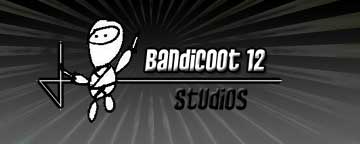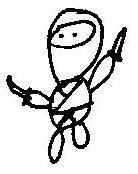
Let's face it: Smash Bros. is popular as hell. It's a fanboy's dream come true. An assortment of beloved characters in an immense crossover where your wildest fanfiction dreams play out in button mash murder. Since the franchise's inception, there have been many emulations of the crossover party fighter concept, from Capcom's Onimusha Buraiden to Ubisoft's upcoming and none-too-subtle named TMNT: Smash Up. Let's forget that Castlevania Judgment business altogether, shall we? I'd prefer it stays locked up in the recesses of supressed memory far deeper than my being molested as a child by Lee Majors.
Now it's Square Enix's turn at the plate, and they've come swinging the Nail Bat (materia is for pussies) with Dissidia, a hyperactive crossover brawler for the PSP featuring the main protagonists and villains from each entry of the first ten Final Fantasy games.
Now, as a reviewer, it's my duty to remain as unbiased as possible and give each game a fair rundown based on its own merits in a completely objective fashion. However, as this is the Final Fantasy franchise, this is absolutely damn well impossible for me to do. That being said, the series died with Final Fantasy X. Additionally, forgive the following fangasm (please insert "squees" wherever you feel appropriate).
OKAY GET THIS THE MASAMUNE IS LIKE 15 FEET LONG NOW AND FIRION CAN USE THE BLOOD SWORD AS HIS LIMIT BREAK ALSO CHAOS IS VOICED BY KEITH DAVID HOW RAD IS THAT MOOGLES CHOCOBOS CLOUD ESPERS KAWAII DESU NE!!!11one
Ahem. Moving along, let's take a look at the game beyond the fanservice.
It goes without saying that anything produced by Square Enix will push the graphical boundaries of any system to its limits, and Dissidia does not disappoint. The lush, vibrant visuals are unbelievably dazzling, from the gorgeous FMV cutscenes to the epileptic laser-shows of every battle. The graphics engine improves upon the one last seen on PSP in Final Fantasy VII: Crisis Core with smoother animations and better particle effects. Most of the character models themselves are a sight to behold, particularly characters from the 8 and 16 bit games that have been wonderfully recreated from the original art of Amano Yoshitaka (expect lots of horns). On the other end of the presentation spectrum is Dissidia's wondrous score. Newer pieces such as One Winged Angel and Jecht's theme return, along with excellent remixes of the standout pieces from each title (Gilgamesh's theme and series staple Prelude sound friggin' amazing). In addition to the expected new arrangements, Dissidia composer Ishimoto Takeharu introduces a handful of original songs, including a vocal piece and a piano instrumental nearly the caliber of Uematsu's work. The quality of the voice work is parabolic, with strong performances like Johnny Yong Bosch (of DMC4 fame) as Firion and disappointingly wretched vocal fare, such as Bryce Papenbrook's Zidane. Again, I lament that Square Enix never includes the option to switch vocals back to the original Japanese (Sakurai Takahiro's Cloud is impeccable).
I fiddled with the Japanese version of Dissidia upon its release late last year, and I was completely shut out by the schizophrenic gameplay and ambiguous damage systems. I chalked my confusion up to language barrier, and now that I can finally play the game in English...well, it's still confusing as hell at times. Gameplay-wise, Dissidia falls more in line with Atari's Dragonball Z: Budokai series. Matches are one-on-one, three-dimensional fare in various exceptionally destructible arenas. All three dimensions are used to full extent, as characters are capable of flying, dashing, running on walls, and other Advent Children-esque chaos. While characters do have health bars, focus lies in the Bravery Gauge, similar to Guilty Gear's Momentum system. Bravery points are depleted with Circle combos, and once the Bravery gauge is depleted, HP damage combos can be employed to their fullest extent with Square. It keeps the entire battle a game of tug of war, and keeping pressure on your enemy while evading BP-crushing combos is vital to a quick victory. It's a nice change of pace from the standard fighter's health gauge or Smash Bros' glorified ring out combat system. Combat is nothing more than messy button mashing, but it's some of the prettiest button mashing you'll ever encounter.
Beyond the frantic combat itself is a staggeringly deep portable experience. Along with the standard arcade and versus modes (both CPU and multiplayer), the game features a full nonlinear story mode that plays out similarly to the tactical battles sections of Suikoden III. Character customization is expansive, with alternate costumes, fully customizable movesets and abilities, a shop system, Espers, and all the other RPG element dressings to remind you this is Final Fantasy (oddly enough, the game has a menu-based battle option to make it feel even more like the originals). Throw in the ton of unlockables and online play, and Dissidia becomes a pretty nice package for the PSP.
Now, as I said, it's impossible for me to review this game without bias. I spent years obsessed with this franchise. I wrote fanfiction. I ran roleplaying guilds. I created an FF-based pen and paper RPG from scratch. I have played every single game and memorized so many facets of the overall mythos you'd think I was a Trekkie. For Mog's sake, my own loathing of Final Fantasy VIII brought me together with my fiancee. Truly, the original Final Fantasy series holds a deep meaning for me. Regardless, the game manages to properly pay homage to the franchise and replicate the epic feel of the battles with the chaotic battle system, so brawler/fighter fans will probably enjoy this anyway (it's not as though there are many alternatives on the handheld). But for those of you like myself who have loved this franchise and its many wonderful stories and memorable characters for years, this will be a treat. I cannot resist the widest of grins upon the imposing first notes of One Winged Angel's cacophony or be overcome by gooseflesh upon seeing Garland knock you all down in the Chaos Temple or feel a powerful tinge of delight seeing characters like Exdeath and Cecil Harvey represented in glorious 3D and on such a grand stage. Truly, if you are any sort of FF-fanboy, this will hold all the same sweeping nostalgia as Nintendo's own fanservice brawler.
Dissidia: Final Fantasy is just as bizarre and rowdy as its name. Its convoluted battle system and its grandiose presentation of gaming's foremost RPG series earns it a cavalcade of mixed feelings and truly makes it one very spoony bard.
Final Score: In lieu of a numerical score, my review of the game rests simply that fans will eat it up and I cannot speak for anyone else. Or, if you're really damn pushy about it, I guess an 8.0 or something.
Seriously, though, the storyline is an utter ripoff of a concept I created seven years ago...jerks.














